 In this series (within the 130 authors survey), I’m sharing women’s views on exploring sexuality through fiction. If you haven’t already read Part One, it’s the best place to begin.
In this series (within the 130 authors survey), I’m sharing women’s views on exploring sexuality through fiction. If you haven’t already read Part One, it’s the best place to begin.
Here, we look at recurring themes within erotic fiction.
What do we find to challenge and empower us?
What motivates us to write within this diverse, often liberating, yet sometimes misunderstood genre?
Writing ‘sex’ is a pathway to understanding. We recognize that we are more than intellect, and more than emotion. We are also ‘of the body’.
In writing erotic fiction, we use sex as the lens through which we explore our world and our identity.
We, as writers, look at how sexual impulse shapes our motivations, and how it impacts our relationships.
We speak our desire and, in doing so, our voices only become more powerful.
At its best, erotica reaches far beyond formulaic parameters and the ‘comfort’ of perceived ideals.
At its best, there are no parameters.
Kristina Lloyd asserts, “The erotic disrupts, destabilizes and threatens order, both personal and social, and its power is widespread and pervasive.”
 Christina Mandara voices the opinion that women’s reading material is being dictated to them: a view shared by Sorcha Black, who believes, “The policing of women’s sexuality includes censoring what we read.”
Christina Mandara voices the opinion that women’s reading material is being dictated to them: a view shared by Sorcha Black, who believes, “The policing of women’s sexuality includes censoring what we read.”
While being receptive to critique (as would be expected in any genre) we, as authors, need to stand resolute in our belief that sexuality is a valid theme for literary exploration, and that we have the power to write as we see fit.
I.G. Frederick notes, with frustration, “It’s perfectly acceptable to use sex to sell anything from cars to beer, but we’re discouraged from examining the impact of sex on relationships in works of fiction.”
Many of the women taking part in this survey note commercial ‘constraints’ within the genre — such as are difficult to ignore for any writer seeking to earn an income from their work. However, we can argue that responsibility lies with us, as authors, to become less commercially risk-averse. If we write from a place of truth, we’ll find our audience.
Brantwijn Serrah praises erotica’s ability to play with possibilities, assisting ‘readers and authors in exploring new ideas about sexuality’.
Fiction Mirrors and Identifying the ‘Self’
In exploring the psychology of desire, how we behave ‘in the raw’, erotic fiction invites us to open our minds to all possibilities. It has the power to delve not just our fantasies but our truths. It holds a mirror to versions of our ‘self’ rarely let out in polite company; within that mirror, we gain deeper understanding.
 Remittance Girl, in her article, On Writing Erotica, explains her desire ‘to articulate the conflict within ourselves, to make sense of it, and then to reach out to others via the page’. Nya Rawlyns believes the genre has the power to ‘redefine how we see ourselves and our society’.
Remittance Girl, in her article, On Writing Erotica, explains her desire ‘to articulate the conflict within ourselves, to make sense of it, and then to reach out to others via the page’. Nya Rawlyns believes the genre has the power to ‘redefine how we see ourselves and our society’.
Sessha Batto emphasizes that her goal is ‘to trace a character’s growth, as revealed through sex’ and to ‘dig deeply into a character’s personality and motivations’, as ‘catalysts for growth and personal discovery’.
Malin James states, “Authorial intent comes down to one thing: I want to understand.” She underlines that fiction ‘can reflect the human condition in all its individual, specific forms. It can explore the cause and effects that drive our lives and form our emotional realities.” She adds, “I write to explore and reflect experiences. I like digging beneath a constructed, social surface to get at an emotional reality.” – read more from Malin on her intent here and here
Fantasy v. Realism
Fantasy (all the ‘what ifs’ of our imagination) is a well-recognised aspect of erotic fiction. If not here, then where else, can we explore ‘the forbidden’. As Malin James stresses, “While a great deal of erotica falls into a realistic vein, much of what people actually want is that which they can’t (or don’t feel they can) have in real life. This is why rape fantasies, incest and other transgressive sexual acts continue to sell erotica and generate clicks.” – more on ‘fantasy’ here
Janine Ashbless sees fiction as ‘a safe area in which to let our darker selves, our fears and our desires, out for a little exercise…’
It may seem contradictory to seek out greater realism within erotic fiction. However, the majority of writers with the 130 authors survey assert a desire to write recognizable, diverse characters, and situations, with psychological depth, to better allow readers to empathize, and enter into alternate possibilities.
However, the majority of writers with the 130 authors survey assert a desire to write recognizable, diverse characters, and situations, with psychological depth, to better allow readers to empathize, and enter into alternate possibilities.
Siri Ousdahl declares, “I’d like there to be a larger place for high-quality, graphic sex writing: fiction that is not coy, does not romanticize or trivialize, and is psychologically realistic.”
Tobsha Learner comments, “I like to make my characters normal people with fallible, normal bodies of all ages. The premise being that lust, sex and love is not just something that happens to gorgeous under thirty year olds, with ridiculously youthful and beautiful billionaires.” She asserts, “There is a certain joyful bawdy finger up to the Heavens when such coup de foudres fall upon our heads, whether we be 80, 50, 30 or 16.”
Similarly, CA Bell declares, “I’d like to see sexy, real, and honest writing: no billionaires who can shag for hours and come five times a night.” In her own words, Elizabeth Safleur writes ‘contemporary billionaire erotic romance with a lot of fantasy’ but admits that she’d ‘like to read stories that involve real people, who aren’t great at being together (yet) and figure it out’. She adds, “Instead of the sex being amazing right off the bat, what did they do to make it great? I’d like to read something that allows for insecurities… vulnerabilities can be sexy.”
Diversity
Krissy Kneen tells us, “I’d like to see a broader range of people represented, fat people, old people, the disabled, all types of sexual orientations. I’d also like to see more gender fluidity. I think the masculine/feminine divide is boring and needs to be retired. Manly men and femme women is a cliché that really must go.”
Zak Jane Keir is keen to see more trans characters represented in stories  (where the plot extends beyond the surprise reveal of them actually being a §transperson). She laments the ‘generic’ in erotic fiction.
(where the plot extends beyond the surprise reveal of them actually being a §transperson). She laments the ‘generic’ in erotic fiction.
Sorcha Black also asserts her goal of challenging assumptions about gender roles and sexual attraction by avoiding ‘stereotypes’. She explains, “A lot of my characters are sexually fluid and are also into kink. I don’t have to limit myself to what’s expected. It’s far too easy to paint caricatures.”
On the theme of ‘perfection’, Madeline Moore states, ”We’re all looking for it and when we’re in love we believe, for a brief time, that we’ve found it.” However, she laments that women often feel that sexual encounters should be ‘perfect’, while men have ridiculous expectations of ‘perfection’.
Lily Harlem underlines her interest in exploring flawed characters, ‘because no one in real life is perfect or makes the right decisions all of the time’. Meanwhile, Donna George Storey notes that fantasy sex is ‘soothing’ but that she’s ‘now trying to capture something more real’. She explains, “I appreciate that erotic fiction often explores a world where characters are free of sexual repression. You meet a gorgeous partner, fall into bed immediately, and the physical  experience is fantastic even though you don’t know his/her name. The female version usually has the gorgeous partner falling in love for the first time in his life after the aforementioned great sex.” Donna asserts, “I’d like to see more celebration of the magic of sex between people who know each other well. I’d like to acknowledge that time and trust are important in creating a situation where great sex can happen. Couples who’ve been together for a long time are not necessarily bored with each other. They can go deeper, they can play, they know each other well enough to trust it will be mutually enjoyable.”
experience is fantastic even though you don’t know his/her name. The female version usually has the gorgeous partner falling in love for the first time in his life after the aforementioned great sex.” Donna asserts, “I’d like to see more celebration of the magic of sex between people who know each other well. I’d like to acknowledge that time and trust are important in creating a situation where great sex can happen. Couples who’ve been together for a long time are not necessarily bored with each other. They can go deeper, they can play, they know each other well enough to trust it will be mutually enjoyable.”
Cecilia Tan notes her aim to write ‘power dynamics between lovers’ and the ‘ways they explore each other’s inner lives, imagination, and fantasies’.
In the realm of BDSM themed erotic fiction, Nicolette Hugo would like to see ‘alternate sexuality explored more positively’, stating her irritation with ‘sadism being relegated to villains.’. KD Grace explains, “I’m sick to death of weak, cardboard women being written as subs and mean, unlikable, men being written as Doms (or, even worse, as really creepy, stalker types). I want depth, I want a connection that has more to do with what drives the characters, and with the chemistry between them, and less to do with the trappings.”
Zak Jane Keir expresses her desire ‘to share a worldview that isn’t entirely mainstream’.
Meanwhile, Adrea Kore reminds us, “Human sexuality is vast, varied, and complex. The spectrum of people’s turn-ons and kinks is almost verging on infinite. And so is writing about it. As authors, we don’t all have to be covering the same ground… there is room for diversity.” – more here
Themes: Identity
Many authors view ‘identity’ as a prevalent theme, often expressed through understanding of the self (and what motivates our behaviour). Cate Ellink describes this as ‘finding your place in the world’. Malin James notes that she is drawn by the fluidity of the concept of self, and ‘sexuality as a window into deeper understanding of ourselves and each other’.
Cari Silverwood asserts that her stories aim to make us question our ‘relationship with the world and humanity’, to the point where we are ‘uncomfortable and, even, disturbed’. She embraces writing fiction with ‘an inherent moral challenge’.
Remittance Girl, in exploring darker elements of human nature — ‘guilt,  mistrust, fear and emotional wounding’ — shows characters obliged to ‘reconstruct their identity in the light of what they’ve done’ –more here. We watch her characters push through their inner-sanctions, and see how they deal with the consequences. In this way, her work exposes our uncertainty and our inconsistencies.
mistrust, fear and emotional wounding’ — shows characters obliged to ‘reconstruct their identity in the light of what they’ve done’ –more here. We watch her characters push through their inner-sanctions, and see how they deal with the consequences. In this way, her work exposes our uncertainty and our inconsistencies.
Elizabeth Safleur states her fascination with the theme of ‘becoming more yourself’, telling us, “Most of my women are fiercely independent… [but] often find it difficult to reconcile that quality with their submissive and other kink/BDSM yearnings. I’ve noticed a new pattern lately, which is people believing they don’t deserve love, not deep down. Who said writing isn’t cathartic?”
Brantwijn Serrah also explores the theme of identity, of ‘who we are in our most naked moments’. She asserts, “It’s amazing to me how much can be understood through our sexual self.” Nicolette Hugo similarly refers to ‘acceptance of self’ as a theme in her work.
Themes: Truth and Deceit
So many authors, across the centuries, have sought ‘truth’ and, conversely, examined the deceits we perpetrate.
Erotic fiction well lends itself to exploring ‘grey areas of morality’, as Tobsha Learner calls them: to the small lies we tell ourselves, to our unspoken motivations, to the ways in which we manipulate or make use of others. Nicolette Hugo refers to this ‘moral duality’ in her own work, alongside ‘the marriage of sex and violence’.
Donna George Storey states her major theme as ‘the lies we tell, whether malevolent or benevolent… and especially lies involving sex’. Donna explains, 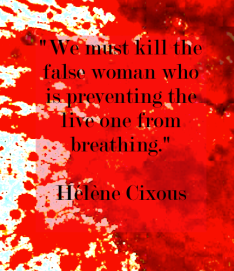 “I love exploring the slippery relationship between truth and fiction. The stories I value convey truths that spring from careful thought and deep feeling, truths we often keep secret from others and ourselves. Exploring those truths is what I aim for when I write.”
“I love exploring the slippery relationship between truth and fiction. The stories I value convey truths that spring from careful thought and deep feeling, truths we often keep secret from others and ourselves. Exploring those truths is what I aim for when I write.”
Sessha Batto views sex as ‘a vehicle of revelation, a way to expose characters when they are most open and vulnerable’. She writes sex to ‘expose the parts we tend to keep hidden’.
Themes: Freedom and Constraint
Another common theme for exploration is that of the nature of freedom (as explored in Siri Ousdahl’s novel, ‘Constraint’). We speak of sexual liberation as a form of ‘freedom’: to make our own choices, without inhibition or shame.
The pursuit of freedom is a preoccupation of my own, although I little realized it when I began writing, exploring the myriad ways in which women are ‘pinned’, ‘exhibited’ and ‘dissected’ by society.
Cecilia Tan takes this idea further in linking sexual expression to creative expression. “Just last weekend I was in a workshop for writers where I discovered that one of my main underlying themes is equating sexuality with creativity at a metaphoric level. My characters tend to be not only on a search for love and sexual gratification; this is usually tied up with their need for creative or artistic expression.”
 She adds that the public versus private face of a person can exist not only in terms of their sexuality (how they express it to the world versus how they are in private) but their art form (dance, painting, sculpture, music, songwriting, writing, and so on).
She adds that the public versus private face of a person can exist not only in terms of their sexuality (how they express it to the world versus how they are in private) but their art form (dance, painting, sculpture, music, songwriting, writing, and so on).
Themes: Connection, Yearning, Trust
Tobsha Learner asserts, “The erotica reader doesn’t just want to look; they want to be in the skin of the protagonists. They need to feel the aching frustration and longing and then the blissful release of orgasm, both in the emotional, physical and sometimes spiritual sense.”
Tobsha underlines the importance of ‘psychological foreplay’ in erotic fiction (a factor that is largely irrelevant to pornography) – more here.
Lily Harlem asserts her exploration of the ‘many complications that arise from the emotions of love and lust’ – a theme mentioned by many who responded to the 130 authors survey. A significant number underlined, as we might expect, interest in delving the complexities of connection and, as Malin James calls them, ‘social and sexual power dynamics’.
Kay Jaybee, alongside quite a few of the respondent authors, is fascinated by the BDSM world. She tells us, “I don’t inhabit that world, but the psychology of it, the dynamic of total trust that it requires, is an endless source of inspiration.” Meanwhile, Madeline Moore tells us that she writes about people who are ‘in a state of yearning’ or ‘obsession’.
 Themes: Mortality
Themes: Mortality
Shanna Germain notes her desire to break open the relationship between sex and death, to ask her characters ‘How are you going to handle this? Will you grow and change? Will you show your true self? Or will you hide?’ Malin James, too, finds herself returning often to explorations of mortality and ‘the relationship between sex and death’, as does Christina Mandara.
Cultural Relevance
Shanna Germain underlines that, of all genres, erotica (and horror) most reflect ‘the mores of our current culture’. She tells us, “Sci-fi looks ahead, fantasy looks back, literary fiction looks askance. But erotica looks right at the now and says, ‘This is happening, in the streets, in the bedrooms, in the bars.’ Where will erotica, as a genre go? It will go where the culture goes. I hope it goes somewhere open-minded, joyous, and hot as fuck.”
As Remittance Girl asserts, “I hope that I can play some small role in the evolution of erotic writing and help, if only in a tiny way, to push it into the light, and towards being recognized as a fertile and unconstrained form of critically recognized literature.” She urges us, “We are adventurers. We are explorers. Be brave. Dare to write what frightens and unsettles us, as well as what delights us. In doing so, we may write words worth remembrance.” – more here
It’s time for us to write our own rules.
We can be whoever we wish to be.
Own your sexuality, own your voice, own your words.
In Part Three: Inspirations, influences, and the relevance of gender
Further Reading
Coming Soon…
Writing Craft
Authors’ Recommended Reads
Author Influences: music, theatre, dance, fiction, art
My thanks go to the following authors for giving their time and for their candid answers; my thanks also to authors who contributed their views anonymously.
Tobsha Learner, Laura Antoniou, Susan St. Aubin, Shanna Germain, Remittance Girl, Malin James, Janine Ashbless, Adrea Kore, Kristina Lloyd, Cecilia Tan, Donna George Storey, Kathe Koja, Justine Elyot, Sorcha Black, Cari Silverwood, Siri Ousdahl, Zander Vane, Tamsin Flowers, Krissy Kneen, Zak Jane Keir, Jade A Waters, KD Grace, Kay Jaybee, Nya Rawlyns, Sessha Batto, Rose Caraway, Tabitha Rayne, Elizabeth Safleur, Devi Ansevi, K. L. Shandwick, I.G. Frederick, Jacqui Greaves, Ina Morata, Finn Marlowe, Elsa Holland, Elizabeth Schechter, Lucy Felthouse, Alexis Alvarez, Lily Harlem, Madeline Moore, Ria Restrepo, Scarlet Darkwood, Victoria Bliss, Jane Gilbert, Charlie Powell, Cate Ellink, Lee Savino, Elizabeth Black, Felicity Brandon, Nicolette Hugo, Amelia Smarts, Sue MacNicol, Cassandra Shaw, Ardent Rose, Sylvia Storm, Renee Rose, Rachel de Vine, Cherry Wild, Patient Lee, Pandora Spocks, Suzette Bohne’ Sommers, Molly Synthia, Meg Amor, Lizzie Ashworth, Cara Bristol, Finn Marlowe, C.A. Bell, Brantwijn Serrah, Aubrey Cara, Kathleen Bradean, Stormchase, Lisa Fox, Allyson Young, Emma Jaye, Dee Maselle, Christina Mandara, Sue Lyndon, Rebecca Branch, Molly Moore, Vanessa Wu, Jaye Peaches, Ashe Barker, Tilly Andrews and Catherine Mazur.
 salacious tales and images based on male servants spying through keyholes, in hope of catching members of the family or staff having sex. This saucy imagery was at its most popular when the ‘butler’ caught a romp taking place between people of different classes; the lord and the maid, or the lady and the stable boy. In other words, the more illicit the liaison, the sexier it was to watch.
salacious tales and images based on male servants spying through keyholes, in hope of catching members of the family or staff having sex. This saucy imagery was at its most popular when the ‘butler’ caught a romp taking place between people of different classes; the lord and the maid, or the lady and the stable boy. In other words, the more illicit the liaison, the sexier it was to watch. Despite their slave status, Anya and Clara are intelligent professional women who’ve chosen employment with Mark Parker – the ultimate voyeur. In their six months of working for Mark, he’s barely touched them, but boy has he watched them in action!
Despite their slave status, Anya and Clara are intelligent professional women who’ve chosen employment with Mark Parker – the ultimate voyeur. In their six months of working for Mark, he’s barely touched them, but boy has he watched them in action!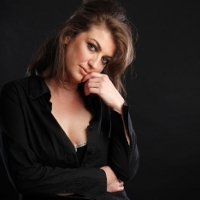 2018), The Voyeur (Sinful Press, 2018), Knowing Her Place-Book 3: The Perfect Submissive Trilogy, (KJBooks, 2018), The Retreat- Book2: The Perfect Submissive Trilogy(KJBooks, 2018), Making Him Wait (Sinful Press, 2018), The Fifth Floor- Book1; The Perfect Submissive Trilogy (KJBooks, 2017), Wednesday on Thursday, (KDP, 2017), The Collector (KDP, 2016), A Sticky Situation (Xcite, 2013), Digging Deep, (Xcite 2013), Take Control, (1001 NightsPress, 2014), and Not Her Type (1001 NightsPress), 2013.
2018), The Voyeur (Sinful Press, 2018), Knowing Her Place-Book 3: The Perfect Submissive Trilogy, (KJBooks, 2018), The Retreat- Book2: The Perfect Submissive Trilogy(KJBooks, 2018), Making Him Wait (Sinful Press, 2018), The Fifth Floor- Book1; The Perfect Submissive Trilogy (KJBooks, 2017), Wednesday on Thursday, (KDP, 2017), The Collector (KDP, 2016), A Sticky Situation (Xcite, 2013), Digging Deep, (Xcite 2013), Take Control, (1001 NightsPress, 2014), and Not Her Type (1001 NightsPress), 2013.

 protagonists’ comfort zones (and, thereby, those of the reader).
protagonists’ comfort zones (and, thereby, those of the reader). Lady Tia wafted into Elena’s study in a haze of musky perfume. As she clicked on her screensaver, the Scotswoman peered at her assistant over the rim of her glasses. ‘Good evening, Lady Tia. Thank you for coming so promptly.’
Lady Tia wafted into Elena’s study in a haze of musky perfume. As she clicked on her screensaver, the Scotswoman peered at her assistant over the rim of her glasses. ‘Good evening, Lady Tia. Thank you for coming so promptly.’ Kay Jaybee has over 180 erotica publications including, The Retreat- Book2: The Perfect Submissive Trilogy (KJBooks, 2018), Making Him Wait (Sinful Press, 2018), The Fifth Floor- Book1;The Perfect Submissive Trilogy (KJBooks, 2017), Wednesday on Thursday, (KDP, 2017), The Collector (KDP, 2016), A Sticky Situation (Xcite, 2013), Digging Deep, (Xcite 2013), Take Control, (1001 NightsPress, 2014), and Not Her Type (1001 NightsPress), 2013.
Kay Jaybee has over 180 erotica publications including, The Retreat- Book2: The Perfect Submissive Trilogy (KJBooks, 2018), Making Him Wait (Sinful Press, 2018), The Fifth Floor- Book1;The Perfect Submissive Trilogy (KJBooks, 2017), Wednesday on Thursday, (KDP, 2017), The Collector (KDP, 2016), A Sticky Situation (Xcite, 2013), Digging Deep, (Xcite 2013), Take Control, (1001 NightsPress, 2014), and Not Her Type (1001 NightsPress), 2013.
 “I found that my storytelling always turned to erotic themes, and felt ashamed to be writing “dirty stories.” Serendipitously, at that time I came upon a trio of inspiring books: The Mammoth Book of International Erotica, edited by Maxim Jakubowski; Best American Erotica 1997, edited by Susie Bright, and Diane di Prima’s Memoirs of a Beatnik. These books showed me that erotica can be intelligent, challenging and mind-expanding, exciting to the mind as well as to the libido. Di Prima’s contention that “there are as many kinds of kisses as there are people on the earth” and her brilliant description of several kissing styles still amazes and challenges me to capture the truth of the erotic experience in my own work. I must add, however, that it’s only the first two chapters of Memoirs of a Beatnik that I liked—the chapters about her affair with Ivan that had plenty of romance and emotion. After that, the book devolves into what it apparently was—stories written for the rent money for a pornographic press. The difference between the two sections was instructive to me. I adore sex stories with some sense of attraction beyond the physical, but am impatient with formulaic writing. Di Prima did actually have an affair with a man like Ivan. I’m not saying all writing is autobiographical in the strictest sense, but that section felt very real. That’s what I aspire to in my writing.”
“I found that my storytelling always turned to erotic themes, and felt ashamed to be writing “dirty stories.” Serendipitously, at that time I came upon a trio of inspiring books: The Mammoth Book of International Erotica, edited by Maxim Jakubowski; Best American Erotica 1997, edited by Susie Bright, and Diane di Prima’s Memoirs of a Beatnik. These books showed me that erotica can be intelligent, challenging and mind-expanding, exciting to the mind as well as to the libido. Di Prima’s contention that “there are as many kinds of kisses as there are people on the earth” and her brilliant description of several kissing styles still amazes and challenges me to capture the truth of the erotic experience in my own work. I must add, however, that it’s only the first two chapters of Memoirs of a Beatnik that I liked—the chapters about her affair with Ivan that had plenty of romance and emotion. After that, the book devolves into what it apparently was—stories written for the rent money for a pornographic press. The difference between the two sections was instructive to me. I adore sex stories with some sense of attraction beyond the physical, but am impatient with formulaic writing. Di Prima did actually have an affair with a man like Ivan. I’m not saying all writing is autobiographical in the strictest sense, but that section felt very real. That’s what I aspire to in my writing.” On the subject of film, Donna views it as the ‘premier storytelling form of our age’, alongside television. “When my not-so-mainstream novel Amorous Woman was published, a lot of people asked when the movie version was coming out. Not that they were totally serious, but a movie adaptation is the mark of an “important” work of fiction. I’m impressed by the collaborative nature of making a movie; it’s not just one person’s vision. A successful film requires so many different levels of artistry and co-operation. That helps me appreciate how a published work also involves various levels of dedication—editing, publishing, marketing, reaching the reader. Also, I’ve found “how to write screenplays” books more helpful for my fiction than how-to’s aimed at fiction writers. Robert McKee’s Story is an equally useful guide to writing a good novel. The focus on the structure of the story is particularly helpful, as I can sometimes get lost in the words when I’m writing.”
On the subject of film, Donna views it as the ‘premier storytelling form of our age’, alongside television. “When my not-so-mainstream novel Amorous Woman was published, a lot of people asked when the movie version was coming out. Not that they were totally serious, but a movie adaptation is the mark of an “important” work of fiction. I’m impressed by the collaborative nature of making a movie; it’s not just one person’s vision. A successful film requires so many different levels of artistry and co-operation. That helps me appreciate how a published work also involves various levels of dedication—editing, publishing, marketing, reaching the reader. Also, I’ve found “how to write screenplays” books more helpful for my fiction than how-to’s aimed at fiction writers. Robert McKee’s Story is an equally useful guide to writing a good novel. The focus on the structure of the story is particularly helpful, as I can sometimes get lost in the words when I’m writing.”


 before and really liked it, but the acting in this particular stage version was excellent, giving me a new understanding of the power of dialogue in advancing a story. I’ve long been aware that dialogue tends to be the most arousing element in an erotic story. I try to step back and listen to my characters speaking to each other, as if I’m watching a play. So, the theatrical experience is an important part of my writing.”
before and really liked it, but the acting in this particular stage version was excellent, giving me a new understanding of the power of dialogue in advancing a story. I’ve long been aware that dialogue tends to be the most arousing element in an erotic story. I try to step back and listen to my characters speaking to each other, as if I’m watching a play. So, the theatrical experience is an important part of my writing.”
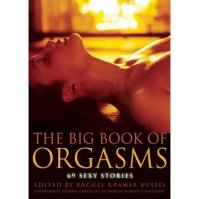 of a lark.”
of a lark.” the writing process,” Malin asserts. “As for what I’d like people to come away with…empathy I suppose. Or resonance. A sense of understanding — feeling understood and, more importantly, gaining an understanding of situations or people who may fall outside their realm of personal experience. My stories should feel like slices of other people’s lives that the reader can experience in some way.”
the writing process,” Malin asserts. “As for what I’d like people to come away with…empathy I suppose. Or resonance. A sense of understanding — feeling understood and, more importantly, gaining an understanding of situations or people who may fall outside their realm of personal experience. My stories should feel like slices of other people’s lives that the reader can experience in some way.” Sarah Waters, Jeanette Winterson, Anais Nin — explore what it is to live, love, hate, and hurt, and they do so beautifully (and arousingly) with sex. They’re an intersection between the literary and erotic,” asserts Malin. “Their exploration of sexual themes occurs with fearlessness and frankness; it’s the lack of implied apology that appeals most to me.”
Sarah Waters, Jeanette Winterson, Anais Nin — explore what it is to live, love, hate, and hurt, and they do so beautifully (and arousingly) with sex. They’re an intersection between the literary and erotic,” asserts Malin. “Their exploration of sexual themes occurs with fearlessness and frankness; it’s the lack of implied apology that appeals most to me.” She adds, “The Magic Toyshop and The Bloody Chamber, by Angela Carter, have made me aware of my sexuality in a much more complicated way, while Muriel Spark’s The Driver’s Seat has opened my eyes to my own lack of sentimentality, just as Affinity, by Sarah Waters, has made me aware of how deeply my empathy runs. Angela Carter’s emphasis on sexuality as mundane, profane
She adds, “The Magic Toyshop and The Bloody Chamber, by Angela Carter, have made me aware of my sexuality in a much more complicated way, while Muriel Spark’s The Driver’s Seat has opened my eyes to my own lack of sentimentality, just as Affinity, by Sarah Waters, has made me aware of how deeply my empathy runs. Angela Carter’s emphasis on sexuality as mundane, profane  and transcendent has definitely influenced my storytelling. Muriel Spark’s work has given me permission to be unflinching and unapologetic with my characters, and Sarah Waters has taught me to pay attention to physical and emotional details, which are often more telling than paragraphs of exposition.”
and transcendent has definitely influenced my storytelling. Muriel Spark’s work has given me permission to be unflinching and unapologetic with my characters, and Sarah Waters has taught me to pay attention to physical and emotional details, which are often more telling than paragraphs of exposition.” England). She underlines, “My acting training (as well as the critical training I received during my MA) directly influences my writing in many subtle ways: particularly in how I approach characters and the circumstances that inform the narrative arc. I think of writing in terms of lenses and angles—sex is, very often the lens, but the angle is determined by influences, from things I’ve done and read.”
England). She underlines, “My acting training (as well as the critical training I received during my MA) directly influences my writing in many subtle ways: particularly in how I approach characters and the circumstances that inform the narrative arc. I think of writing in terms of lenses and angles—sex is, very often the lens, but the angle is determined by influences, from things I’ve done and read.” published by Go Deeper Press. Malin also names David Ives’ Venus in Fur, for its ‘cleverly subversive viciousness’ and Prelude to a Kiss, for its ‘use of magical realism to examine a woman’s fear of death’.
published by Go Deeper Press. Malin also names David Ives’ Venus in Fur, for its ‘cleverly subversive viciousness’ and Prelude to a Kiss, for its ‘use of magical realism to examine a woman’s fear of death’. than plot. She names The English Patient, Bram Stoker’s Dracula (directed Francis Ford Coppola) and Gilda (starring Rita Hayworth) as influential films for her writing, as well as Hitchcock’s Rear Window, Shadow of a Doubt and Vertigo. “While they’re all very different, there’s something compelling in their emotional landscape: a tension and melancholic tragedy. That said, one of my favorite movies of all time is Clue; I love the ridiculous humor of it.”
than plot. She names The English Patient, Bram Stoker’s Dracula (directed Francis Ford Coppola) and Gilda (starring Rita Hayworth) as influential films for her writing, as well as Hitchcock’s Rear Window, Shadow of a Doubt and Vertigo. “While they’re all very different, there’s something compelling in their emotional landscape: a tension and melancholic tragedy. That said, one of my favorite movies of all time is Clue; I love the ridiculous humor of it.”





 You can purchase Leslie’s Giving You box set at
You can purchase Leslie’s Giving You box set at 






 Music is a huge influence in Tabitha’s work. She reveals, “If I want to feel horny, to get in the mood for a big fuck scene, I put on Whole Lotta Love by Led Zepplin. God, that is a sexy song. Honestly, I could go on for hours about music. I go to see bands and concerts a lot and get so fired up. No musical genre is excluded, from country to classical, rap to rock, folk to jazz, dubstep and drum n bass – I love it all.”
Music is a huge influence in Tabitha’s work. She reveals, “If I want to feel horny, to get in the mood for a big fuck scene, I put on Whole Lotta Love by Led Zepplin. God, that is a sexy song. Honestly, I could go on for hours about music. I go to see bands and concerts a lot and get so fired up. No musical genre is excluded, from country to classical, rap to rock, folk to jazz, dubstep and drum n bass – I love it all.”
 Speaking of her literary influences, Tabitha tells us, “Toni Morrison changed me. She was the first writer, for me, to have sensuality woven throughout every sentence – making it a rich part of her work, rather than a separate thing. In my own writing, I try to keep all things sensual. Not just when I’m writing a sex scene. I like the whole piece to have an air of arousal, of something impending.”
Speaking of her literary influences, Tabitha tells us, “Toni Morrison changed me. She was the first writer, for me, to have sensuality woven throughout every sentence – making it a rich part of her work, rather than a separate thing. In my own writing, I try to keep all things sensual. Not just when I’m writing a sex scene. I like the whole piece to have an air of arousal, of something impending.”
 She has also drawn up plans for a perpetual energy machine using inverted pendulums, and is in the process of designing a hamster wheel: ‘it will be better for their little backs and smoother, for less nocturnal noise annoyance… yes, I have a noisy hamster’.
She has also drawn up plans for a perpetual energy machine using inverted pendulums, and is in the process of designing a hamster wheel: ‘it will be better for their little backs and smoother, for less nocturnal noise annoyance… yes, I have a noisy hamster’. Find a full list of Tabitha’s books
Find a full list of Tabitha’s books 

 Janine also names Angela Carter’s Bloody Chamber as an influence on her own short stories, for style and erotic/fairytale subject matter.
Janine also names Angela Carter’s Bloody Chamber as an influence on her own short stories, for style and erotic/fairytale subject matter.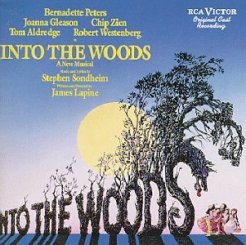 as have Sondheim’s lyrics, which move and inspire her, being ‘clever and emotionally complex’. She enjoys musicals at the tragic end of the spectrum: Cabaret and Jesus Christ Superstar, and Sondheim’s Into the Woods.
as have Sondheim’s lyrics, which move and inspire her, being ‘clever and emotionally complex’. She enjoys musicals at the tragic end of the spectrum: Cabaret and Jesus Christ Superstar, and Sondheim’s Into the Woods.
 When Milja Petak released the fallen angel Azazel from five thousand years of imprisonment, she did it out of love and pity. She found herself in a passionate sexual relationship beyond her imagining and control – the beloved plaything of a dark and furious demon who takes what he wants, when he wants, and submits to no restraint. But what she hasn’t bargained on is being drawn into his plan to free all his incarcerated brothers and wage a war against the Powers of Heaven.
When Milja Petak released the fallen angel Azazel from five thousand years of imprisonment, she did it out of love and pity. She found herself in a passionate sexual relationship beyond her imagining and control – the beloved plaything of a dark and furious demon who takes what he wants, when he wants, and submits to no restraint. But what she hasn’t bargained on is being drawn into his plan to free all his incarcerated brothers and wage a war against the Powers of Heaven. imprison Azazel for all eternity.
imprison Azazel for all eternity. You may like to visit Janine’s
You may like to visit Janine’s 
 Among her favourite such reads is David Schickler’s Kissing In Manhattan collection, which gives readers a ‘strange and seemingly random cast of characters, centred on a mythic Manhattan apartment complex called The Preemption’.
Among her favourite such reads is David Schickler’s Kissing In Manhattan collection, which gives readers a ‘strange and seemingly random cast of characters, centred on a mythic Manhattan apartment complex called The Preemption’. has ever seen before but, if they go too far or are overdone, the film falls flat. For me, kink scenes follow the same logic. I want my sexy story bits to be steamy and hot, but I want to be sure that they’re still grounded in something real. Do body parts actually move and react that way? Is proper safety, negotiation, and consent being observed? Does the kink serve a purpose to the plot and character development or is it more flash over substance?”
has ever seen before but, if they go too far or are overdone, the film falls flat. For me, kink scenes follow the same logic. I want my sexy story bits to be steamy and hot, but I want to be sure that they’re still grounded in something real. Do body parts actually move and react that way? Is proper safety, negotiation, and consent being observed? Does the kink serve a purpose to the plot and character development or is it more flash over substance?”



 About the author
About the author


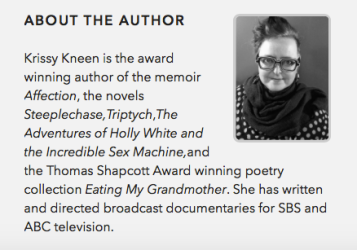
 Krissy explains that her love of literature began when her grandmother would pay her 20c for reading and reviewing books. She adds, “I moved on from stories about mice to Moomintroll, and by the time I hit Ray Bradbury I no longer needed the money. The books themselves became the reward. I started to write because books like R is for Rocket and S is for Space by Bradbury left so much space for me as a reader that I needed to add to the dialogue.”
Krissy explains that her love of literature began when her grandmother would pay her 20c for reading and reviewing books. She adds, “I moved on from stories about mice to Moomintroll, and by the time I hit Ray Bradbury I no longer needed the money. The books themselves became the reward. I started to write because books like R is for Rocket and S is for Space by Bradbury left so much space for me as a reader that I needed to add to the dialogue.” It comes as no surprise that art has inspired Krissy’s work. Her family are visual artists and, as well as designing the sets for a couple of theatre shows in her youth, she enjoyed her own art exhibition. Her Triptych comprises three conjoined novellas, each named after, and referencing, well-known paintings: The Dream of the Fisherman’s Wife, by Katsushika Hokusai; Susanna and the Elders, by Artemesia Gentileshi, and Romulus and Remus, by Peter Paul Rubens. Krissy stresses, “I can’t seem to write anything without the inspiration of the visual arts.” An Uncertain Grace is inspired by a photo created by Sebastio Salgado, which holds a central position in her narrative.
It comes as no surprise that art has inspired Krissy’s work. Her family are visual artists and, as well as designing the sets for a couple of theatre shows in her youth, she enjoyed her own art exhibition. Her Triptych comprises three conjoined novellas, each named after, and referencing, well-known paintings: The Dream of the Fisherman’s Wife, by Katsushika Hokusai; Susanna and the Elders, by Artemesia Gentileshi, and Romulus and Remus, by Peter Paul Rubens. Krissy stresses, “I can’t seem to write anything without the inspiration of the visual arts.” An Uncertain Grace is inspired by a photo created by Sebastio Salgado, which holds a central position in her narrative. best and worst selves, our innermost selves—and who we might become.
best and worst selves, our innermost selves—and who we might become.
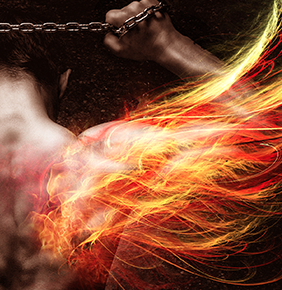
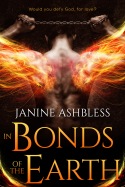 the Watchers trilogy: In Bonds of the Earth. It’s a thought-provoking and immersive novel, setting new standards for paranormal erotic romance. Janine’s authorial style is unforgettable. She likes to write about magic, myth and mystery, dangerous power dynamics, borderline terror, and the not-quite-human. She takes exciting risks in her storytelling; she’s innovative, and she brings fierce intelligence to all she writes.
the Watchers trilogy: In Bonds of the Earth. It’s a thought-provoking and immersive novel, setting new standards for paranormal erotic romance. Janine’s authorial style is unforgettable. She likes to write about magic, myth and mystery, dangerous power dynamics, borderline terror, and the not-quite-human. She takes exciting risks in her storytelling; she’s innovative, and she brings fierce intelligence to all she writes. 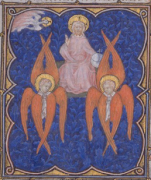 “Stretching up into the great vertical space of the tower, they had become a living helix of light—a caduceus coiled about the pillar of the world. I thought of all the legends from across the Earth. I thought of the Garden of Eden and the Great Dragon of Saint John’s Revelation; stories bookending the whole of human history.
“Stretching up into the great vertical space of the tower, they had become a living helix of light—a caduceus coiled about the pillar of the world. I thought of all the legends from across the Earth. I thought of the Garden of Eden and the Great Dragon of Saint John’s Revelation; stories bookending the whole of human history.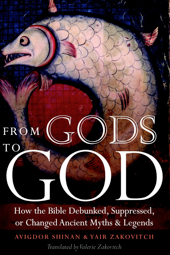 with hands (remember that the Serpent of Eden is punished by being made to crawl in the dust, strongly suggested that it previously had other forms of locomotion).
with hands (remember that the Serpent of Eden is punished by being made to crawl in the dust, strongly suggested that it previously had other forms of locomotion).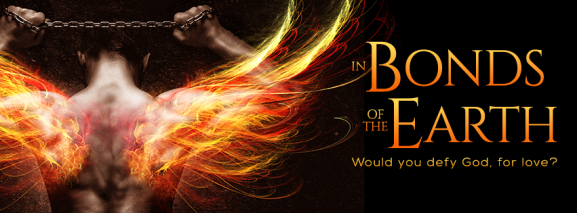
 “Broad at the shoulders and lean at the hips, six foot-and-then-something of ropey muscle, he looks like a Spartan god who got lost in a thrift store. He moves like ink through water. And his eyes, when you get a good look at them, are silver. Not gray. Silver. You might take their inhuman shine for fancy contact lenses. You’d be wrong.” – In Bonds of the Earth
“Broad at the shoulders and lean at the hips, six foot-and-then-something of ropey muscle, he looks like a Spartan god who got lost in a thrift store. He moves like ink through water. And his eyes, when you get a good look at them, are silver. Not gray. Silver. You might take their inhuman shine for fancy contact lenses. You’d be wrong.” – In Bonds of the Earth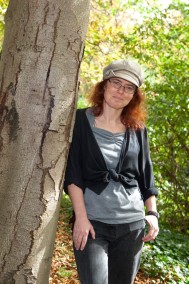

 I
I Always this dance, and writing has helped me embrace the totality in the supposed contradictions.’ – read more
Always this dance, and writing has helped me embrace the totality in the supposed contradictions.’ – read more  Others discovered the liberation of writing much later.
Others discovered the liberation of writing much later.





 Christina Mandara voices the opinion that women’s reading material is being dictated to them: a view shared by Sorcha Black, who believes, “The policing of women’s sexuality includes censoring what we read.”
Christina Mandara voices the opinion that women’s reading material is being dictated to them: a view shared by Sorcha Black, who believes, “The policing of women’s sexuality includes censoring what we read.” Remittance Girl, in her article,
Remittance Girl, in her article, 
 However, the majority of writers with the 130 authors survey assert a desire to write recognizable, diverse characters, and situations, with psychological depth, to better allow readers to empathize, and enter into alternate possibilities.
However, the majority of writers with the 130 authors survey assert a desire to write recognizable, diverse characters, and situations, with psychological depth, to better allow readers to empathize, and enter into alternate possibilities. (where the plot extends beyond the surprise reveal of them actually being a §transperson). She laments the ‘generic’ in erotic fiction.
(where the plot extends beyond the surprise reveal of them actually being a §transperson). She laments the ‘generic’ in erotic fiction. experience is fantastic even though you don’t know his/her name. The female version usually has the gorgeous partner falling in love for the first time in his life after the aforementioned great sex.” Donna asserts, “I’d like to see more celebration of the magic of sex between people who know each other well. I’d like to acknowledge that time and trust are important in creating a situation where great sex can happen. Couples who’ve been together for a long time are not necessarily bored with each other. They can go deeper, they can play, they know each other well enough to trust it will be mutually enjoyable.”
experience is fantastic even though you don’t know his/her name. The female version usually has the gorgeous partner falling in love for the first time in his life after the aforementioned great sex.” Donna asserts, “I’d like to see more celebration of the magic of sex between people who know each other well. I’d like to acknowledge that time and trust are important in creating a situation where great sex can happen. Couples who’ve been together for a long time are not necessarily bored with each other. They can go deeper, they can play, they know each other well enough to trust it will be mutually enjoyable.”  mistrust, fear and emotional wounding’ — shows characters obliged to ‘reconstruct their identity in the light of what they’ve done’ –more
mistrust, fear and emotional wounding’ — shows characters obliged to ‘reconstruct their identity in the light of what they’ve done’ –more  “I love exploring the slippery relationship between truth and fiction. The stories I value convey truths that spring from careful thought and deep feeling, truths we often keep secret from others and ourselves. Exploring those truths is what I aim for when I write.”
“I love exploring the slippery relationship between truth and fiction. The stories I value convey truths that spring from careful thought and deep feeling, truths we often keep secret from others and ourselves. Exploring those truths is what I aim for when I write.” She adds that the public versus private face of a person can exist not only in terms of their sexuality (how they express it to the world versus how they are in private) but their art form (dance, painting, sculpture, music, songwriting, writing, and so on).
She adds that the public versus private face of a person can exist not only in terms of their sexuality (how they express it to the world versus how they are in private) but their art form (dance, painting, sculpture, music, songwriting, writing, and so on). Themes: Mortality
Themes: Mortality